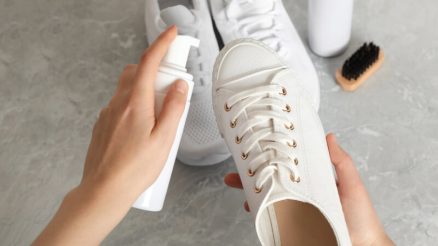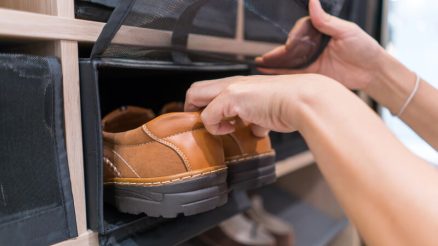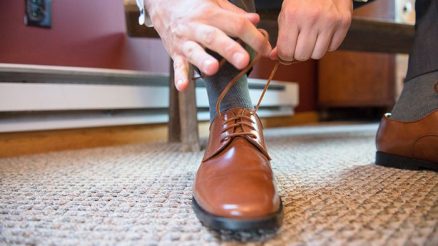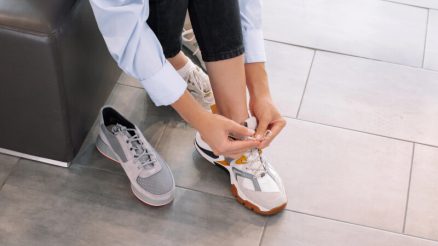Running shoes are more than just footwear; they’re a testament to your dedication and miles logged. Those scuffs and splatters of mud can feel like badges of honor, marking adventures on roads and trails. However, just like any piece of well-used gear, your running shoes will eventually need a good cleaning. The thought of potentially damaging your trusted companions during this process is understandable. Many runners hesitate, fearing that a wrong move could compromise their shoes’ performance or longevity. Fortunately, with the right techniques and a gentle approach, you can safely restore your running shoes to a respectable state, ensuring they continue to support your fitness journey for miles to come.
Gather Your Gear: The Right Tools for the Job
Before you embark on cleaning your running shoes, gathering the appropriate supplies is essential. Using the wrong tools or cleaning agents can indeed lead to damage, so it’s wise to be prepared.
A soft-bristled brush is your first line of defense against dirt and grime. An old toothbrush works wonderfully for this task, or you can invest in a dedicated shoe brush. The key here is softness, especially when it comes to the shoe’s upper. Delicate knit fabrics, common in many modern running shoes, can be easily snagged or damaged by stiff bristles.
For the more robust parts of your running shoes, namely the outsoles and midsoles, a firm-bristled brush will be more effective at dislodging stubborn dirt. These areas endure the most contact with the ground and often accumulate caked-on mud and debris.
The choice of cleaning solution is also crucial. Opt for a mild detergent or a cleaner specifically designed for shoes. Harsh chemicals can cause discoloration or even break down the materials of your shoes. Brands like Under Armour and Nike specifically recommend mild detergents. Shoe-specific cleaners are also readily available and formulated to be gentle yet effective.
Warm water is another essential component, as it helps to loosen dirt and grime, making it easier to remove. Adidas highlights the benefit of warm water in the cleaning process.
Having a few soft cloths or towels on hand will be necessary for wiping away soapy residue and drying your shoes. Microfiber cloths are particularly good as they are absorbent and gentle.
Beyond the essentials, a few optional items can further enhance your cleaning efforts. Baking soda is a fantastic natural deodorizer and can also help lift stubborn stains. White vinegar is another versatile option, known for its stain-removing and disinfecting properties. To help your shoes maintain their shape while cleaning and drying, consider using shoe trees or stuffing them with newspaper. Finally, a mesh laundry bag can be useful for safely washing your shoelaces in the washing machine.
The variety of readily available cleaning agents suggests that effective shoe cleaning doesn’t require specialized products, although they can be beneficial. The choice often comes down to personal preference and the severity of the cleaning needed.
Step-by-Step Cleaning Guide: Gentle Does It
With your gear assembled, it’s time to get down to the business of cleaning. Remember, a gentle approach is key to preserving the integrity of your running shoes.
- Preparation is Key: Start by taking your shoes outside and gently tapping the soles together to dislodge any loose dirt or debris. This simple step, recommended by brands like Under Armour and On , prevents you from spreading dirt around your cleaning area. Next, use your dry soft-bristled brush to remove any remaining surface dirt from all parts of the shoes. Doing this before introducing any water will prevent the dirt from turning into a more stubborn mud. The final step in preparation is to remove the shoelaces and insoles from your running shoes. Cleaning these components separately ensures a more thorough job and prevents moisture from getting trapped inside the shoe, which can lead to unpleasant odors and potential material damage.
- Cleaning the Laces: You have a couple of options for cleaning your laces. For hand-washing, soak them in warm water mixed with a mild detergent or dish soap for about 15 to 20 minutes. Gently scrub them with a soft brush or even just with your hands to remove the dirt. Once they look clean, rinse them thoroughly under running water and hang them to air dry. Alternatively, for most fabric laces, you can place them in a mesh laundry bag and toss them in the washing machine with a gentle, cold cycle and your regular laundry detergent. Regardless of the method, always air dry your laces, as the heat from a dryer can cause shrinkage or damage to the plastic tips. If your laces are white and need extra brightening, you might consider carefully soaking them in a diluted bleach solution for a short period, followed by thorough washing and rinsing. However, exercise caution with bleach and consider gentler alternatives like a baking soda paste or a vinegar solution. The availability of various cleaning methods for laces allows for flexibility based on the level of soiling and personal preference.
- Cleaning the Insoles: For the insoles, hand-washing is generally the best approach. Use warm water and a mild detergent. Gently scrub them with a soft brush or a cloth, paying attention to areas that tend to accumulate sweat. If you’re battling odors, sprinkling the insoles with baking soda and letting them sit overnight before brushing it off can be very effective. Other effective cleaning solutions include a baking soda paste or a mixture of vinegar and water. Regardless of the cleaning method, ensure the insoles are air-dried completely before placing them back in your shoes. Avoid soaking foam insoles for extended periods, as this can damage their structure. Given the sweat absorption, gentle cleaning and thorough drying are vital for maintaining hygiene and comfort.
- Cleaning the Outsoles and Midsoles: These parts of your running shoes typically bear the brunt of the dirt. Use your firm-bristled brush and the mild detergent solution to scrub them thoroughly. For those hard-to-reach crevices in the tread, a dirt pick like a toothpick or a skewer can be helpful. If you have white midsoles with stubborn stains, a paste made from baking soda and water or a household cleaning eraser (like a Magic Eraser) might do the trick. After scrubbing, rinse the outsoles and midsoles with water and wipe them down with a towel. The tougher nature of these components allows for more vigorous cleaning compared to the uppers.
- Cleaning the Uppers: The method for cleaning the uppers of your running shoes will depend on the material.
- For mesh uppers, use your soft-bristled brush or a toothbrush along with the mild detergent solution. Gently scrub in the direction of the knit to avoid damaging the fibers. Wipe away any soap with a clean cloth. If you have white mesh shoes, a baking soda and water paste can help to brighten them.
- For canvas uppers, follow a similar approach to mesh, using a soft brush and mild soapy water. Be careful not to scrub too hard, as this can cause fraying of the canvas. For white canvas, you can also try baking soda, vinegar, or diluted bleach, but always with caution.
- For synthetic uppers, you might be able to simply rinse off light dirt under running water. For more stubborn stains, use a soft brush and the mild detergent solution and wipe with a damp cloth.
- Leather and suede uppers require a different approach. These materials are more delicate and should not be saturated with water. For leather, brush off any loose dirt and then wipe the uppers with a specialized leather cleaner and conditioner. For suede, use a suede brush to gently remove surface dirt and a suede eraser to tackle marks. The need for material-specific cleaning methods underscores the importance of understanding what your running shoes are made of.
| Material | Cleaning Method | Cleaning Agents | Drying Method | Things to Avoid |
|---|---|---|---|---|
| Mesh | Soft brush, gentle scrubbing | Mild detergent, warm water, baking soda paste | Air dry, avoid direct heat | Harsh chemicals, excessive scrubbing |
| Canvas | Soft brush, gentle scrubbing | Mild detergent, warm water, baking soda, vinegar | Air dry, avoid direct heat | Harsh scrubbing, high heat |
| Synthetic | Rinsing, soft brush, gentle scrubbing | Warm water, mild detergent | Air dry, avoid direct heat | Harsh solvents, alcohol-based cleaners |
| Leather | Brush off, wipe with damp cloth, leather cleaner/conditioner | Specialized leather cleaner and conditioner | Air dry, avoid direct heat | Soaking, harsh soaps, excessive water |
| Suede | Suede brush, suede eraser | Specialized suede cleaner | Air dry, avoid direct heat | Water, harsh scrubbing |
| Outsole/Midsole | Firm brush, scrubbing | Mild detergent, warm water, baking soda paste, Magic Eraser | Air dry | |
| Laces (Fabric) | Hand wash or machine wash (mesh bag) | Mild detergent, warm water, bleach (for white) | Air dry | Dryer |
| Insoles | Gentle scrubbing | Mild detergent, warm water, baking soda, vinegar | Air dry | Soaking foam insoles excessively |
The Drying Process: Key to Preventing Damage
Once your running shoes are clean, the drying process is just as important to prevent damage and maintain their integrity. The most crucial rule is to never put your running shoes in the clothes dryer. The high heat can warp their shape, damage the adhesives that hold them together, and even cause shrinkage. Similarly, avoid placing your shoes in direct sunlight or near direct heat sources like radiators. The intense UV rays can fade colors and potentially damage the materials.
The best way to dry your running shoes is by allowing them to air dry naturally. To speed up the process and help the shoes retain their shape, stuff them with newspaper or paper towels. Remember to change the paper if it becomes too damp. Place your shoes in a well-ventilated area with a mild temperature and low humidity. Using a fan to circulate air around the shoes can also significantly speed up the drying time. Don’t forget to remove the insoles to allow them to dry separately. Allow your running shoes to dry completely before wearing them again, which can sometimes take up to 24 hours depending on how wet they were.
Things to Avoid: Common Cleaning Mistakes
While cleaning your running shoes, it’s helpful to be aware of some common pitfalls that can lead to damage. One frequent mistake is putting shoes in the washing machine. Unless the manufacturer specifically states that your shoes are machine-washable, this method can often damage delicate materials and weaken the adhesives.
Another common error is using bleach or harsh household cleaners. While bleach might seem like a quick fix for white shoes, it can often lead to discoloration or material damage. Similarly, avoid soaking your shoes for extended periods, as this can weaken the adhesives and damage the materials. When cleaning, especially the uppers, refrain from scrubbing too aggressively, which can damage delicate fabrics. Lastly, as mentioned before, never dry your shoes with direct heat from a dryer, radiator, or direct sunlight. Avoiding these mistakes will go a long way in keeping your running shoes in good condition.
Tips for Maintaining Shoe Integrity: Beyond Just Cleaning
Keeping your running shoes in top shape involves more than just occasional cleaning. Regular maintenance can significantly extend their lifespan and performance. Make it a habit to clean your shoes regularly, rather than waiting until they are heavily soiled. This prevents dirt from setting in and makes the cleaning process easier. If you’re a frequent runner, consider alternating between two pairs of running shoes. This allows each pair to dry completely between runs and helps the cushioning recover. Always ensure your shoes are dried properly after each run, especially if you’ve encountered wet conditions. This prevents the growth of bacteria and unpleasant odors. When choosing cleaning products, opt for those specifically designed for athletic footwear to avoid any unintended damage. Store your running shoes in a cool, dry place away from direct sunlight. Using shoe trees can help them maintain their shape. Finally, make it a practice to brush off any loose dirt after each run. This simple step prevents dirt from embedding itself in the shoe’s materials and acting like sandpaper, potentially causing wear and tear.
Conclusion
Cleaning your running shoes doesn’t have to be a daunting task fraught with the risk of damage. By following these gentle yet effective methods and avoiding common mistakes, you can keep your trusty running companions looking and performing their best for longer. So, embrace those muddy trails and rainy runs, knowing that with a little care, you can keep your stride fresh and your shoes in excellent condition, ready for your next adventure.








